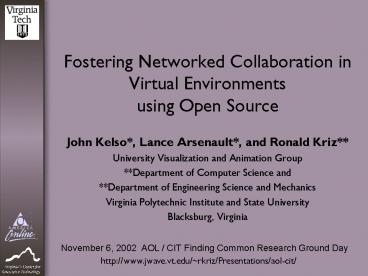Fostering Networked Collaboration in Virtual Environments using Open Source - PowerPoint PPT Presentation
1 / 9
Title:
Fostering Networked Collaboration in Virtual Environments using Open Source
Description:
NIST's RAVE: SAVG. Bose-Einstein Condensate. Examples of physics based simulations and IVRs at: ... DIVERSE used in the CAVE at Virginia Tech (VT) and the RAVE ... – PowerPoint PPT presentation
Number of Views:26
Avg rating:3.0/5.0
Title: Fostering Networked Collaboration in Virtual Environments using Open Source
1
Fostering Networked Collaboration in Virtual
Environments using Open Source
- John Kelso, Lance Arsenault, and Ronald Kriz
- University Visualization and Animation Group
- Department of Computer Science and
- Department of Engineering Science and Mechanics
- Virginia Polytechnic Institute and State
University - Blacksburg, Virginia
November 6, 2002 AOL / CIT Finding Common
Research Ground Day
http//www.jwave.vt.edu/rkriz/Presentations/aol-c
it/
2
Thesis Statement
- Immersive Virtual Reality (IVR), e.g. CAVEs,
IWBs, and HMDs, provides users insight by viewing
their data as 3D objects. - Insight will be enhanced by creation of tools
that allow multiple users (avatars) to be
networked together where they can manipulate 3D
objects in a common shared IVR. - Making same networked tools available on desktop
computers will allow many new users access to IVR
technology. - Collaboration will be enhanced, if these
collaborative desktop tools become as ubiquitous
as the Web browser. - Open-source licensing, e.g. GPL/MPL, fosters
distribution, collaboration, innovation and
domain specific customizations - managing large construction site projects
(e-commerce), - analysis and interpretation of HPC nanostructures
(e-research), - 2007 Jamestown project (e-education distance
learning)
3
Research in a NutshellWe propose to implement a
suite of open-source collaborative tools, and
applications based on those tools, which will
- allow multiple users to share the same IVRs, that
works across a wide range of IVR systems, from
desktop computers to Head-Mounted Displays (HMD)
to fully immersive systems such as CAVEs. - create awareness tools, that allow users to glean
information about other users (avatars) or 3D
objects in a common IVR -- some tools may be
domain specific. - create interaction tools, that allow users to
modify IVR and its content - create collaborative navigational tools, that
allow users to share views, be tethered to other
users, jump next to another user, etc. - Use HCI methods to create tools that are
intuitive and useful - Explore the utility of nontraditional IVR data,
such as sound, voice recognition, and real-time
video
4
Research in a Nutshell (continued)
- create these tools using open-source packages
such as DIVERSE - (www.diverse.vt.edu) a GPL-API for the creation
of Device Independent Virtual Environments
Reconfigurable, Scalable, and Extensible
5
Research Details
- IVR systems used for insight in scientific
research
DIVERSE used in the CAVE at Virginia Tech (VT)
and the RAVE at the National Institute for
Standards and Technology (NIST)
- Examples of physics based simulations and
IVRs at - VTs University Visualization and Animation
Group (UVAG) - NIST Scientific Applications and Visualization
Group (SAVG)
VTs CAVE UVAG fourth-order stiffness tensor
NISTs RAVE SAVG Bose-Einstein Condensate
6
Research Details
- Collaborative IVRs that scale from the desktop to
the CAVE
D_Atomview a DIVERSE application developed at VT
that visually analyzes and interprets
nanostructures predicted by High Performance
Computer (HPC) models. Used both in the CAVE and
a laptop computer using a CAVE simulator.
D_Atomview http//www.sv.vt.edu/future/cave/sof
tware/D_atomview/D_atomview.html D_Collab_Tools
http//anray2.campus.vt.edu1800/user/CollabWebPag
e/
Collaborative CAVE-to-CAVE-to-desktop
demonstration October 2002.
Desktop CAVE-simulator embedded in a
nanostructure -- avatars not shown.
7
Research Details
- Current DIVERSE API and applications run only on
SGI-Irix and Linux operating systems (OS) - Future development will include MS-Windows,
Mac-OSX, and SUN-Solaris - Dynamic Shared Objects (DSOs) facilitate
interactive IVR system configuration and
collaboration.
8
Benefit to AOL
- increased use of networking resources
- in terms number and length of connections,
- in some cases need for increased data transfer
rates to support modalities such as voice and
video. - enhance collaborative design environment that
works independent of discipline content. - As new I/O desktop devices emerge the DIVERSE API
can be used to include these devices as
collaborative tools.
9
Contact Information
- Name John Kelso, Lance Arsenault, and Ron Kriz
- Affiliation Virginia Techs University
Visualization and Animation Group - Phone 540- 231 - 2054 / 2641 / 2062
- Email kelso_at_vt.edu / lanceman_at_vt.edu /
rkriz_at_vt.edu































